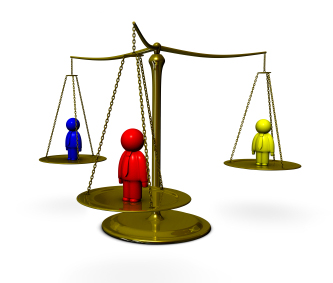

King Leonidas of Sparta.
The people of ancient Sparta apparently had an interesting way of electing their leaders: candidates faced an audience and the one who got the loudest cheers won. While this may seem just as crude as the UK voting system (which has come under much attack lately), there is a crucial difference. The UK system is based on the "one person, one vote" principle: every voter gets to pick one candidate and their opinion about the others remains unheard. With the cheering system, by contrast, people can voice their feeling about all of the candidates, shouting louder for some than for others.
Today there are people who suggest that something similar may provide a good way of electing modern leaders too. The idea is, not to get people to cheer, but to allow voters to rate each candidate on some scale, say from 0 to 10. It means that voters don't have to choose a single candidate, or even rank candidates in order of preference. To find a winner, add up the ratings for each a candidate: the candidate with the highest total wins. It's a voting system used in some sports competitions, for example figure skating, but not in important political elections.
Proponents of such grading systems, as they are called, argue that they have some obvious advantages. If your favourite candidate has little chance of winning, you are no longer faced with the temptation to vote strategically in order to avoid wasting your vote in favour of someone you really don't like. In a grading system, you can give the same rating to both your real favourite and a less palatable, but still acceptable, candidate with a better chance of winning. In the recent UK election, for example, a voter could have decided to give a high rating to both a Green Party and a Labour candidate, expressing their preference for the former, but also supporting the latter in order to keep the Tories out.
If you're a politician you should try and gain the approval of as many people as possible, so a grading system also provides an incentive to broaden your appeal, rather than just trash your opponents. This, one hopes, would put a curb on negative campaigning and the populist playground level of debate we saw in the run-up to the UK general election. Taken together, these advantages might tempt more voters to the ballot box.
Fighting it out
These are partly speculations, but is there a more rigorous way of scrutinising a voting system? One thing election scientists like to do is see what would happen if you pitted candidates against each other in pairs — it's a bit like letting them fight it out, pair by pair, in a boxing ring. If there is one candidate who beats all the other candidates in those pairwise contests, then there's a strong argument that that candidate should win the overall election. If a voting system doesn't return that candidate as the winner, then perhaps it is not quite right.
As an example, suppose there are three candidates A, B and C, and three voters; X, Y and Z. Suppose that, in a grading system, each voter rates each candidate on a scale from 0 to 4 (with 0 being the lowest). Suppose the election gives the following outcome:
| Candidate A | Candidate B | Candidate C | |
| Voter X | 4 | 0 | 0 |
| Voter Y | 2 | 4 | 3 |
| Voter Z | 0 | 1 | 1 |
To decide a pairwise contest, say between A and B, we compare how many candidates rated A higher than B and how many rated B higher than A. In our example only voter X rated candidate A higher than candidate B, but two voters (Y and Z) rated B higher than A. It therefore makes sense to say that B wins the pairwise contest. We get a similar result when comparing A and C, so it's C who wins that particular pairwise contest. Comparing B and C we see that voter Y prefers B to C while no voter prefers C to B — so candidate B wins here. Going by pairwise contests, candidate B should win the overall election, because B has beaten both opponents. (For those familiar with election theory, B is akin to a Condorcet winner in systems that use rankings, rather than ratings.)

Fighting it out in the boxing ring.
What result do we get in a grading system that chooses the person with the highest total as the winner? In that case, candidate A walks away with the crown, having gained a total of 6 while B only managed 5, and C only 4.
This seems rather worrying: our system, based on highest total rating, returns what you might argue is the "wrong" winner. There is an interesting way around this though. In a recent paper, political scientist Steven J. Brams and statistician Richard F. Potthoff showed that if you only allow two ratings (0 and 1) in the grading system, then the winner returned by pairwise comparisons and the one returned by choosing the highest total are always the same. There could of course be more than one winner under both methods, but if that is the case, then the two collections of winners are the same.
To illustrate how two grades resolve the discrepancy between the highest-grade winner and the winner by pairwise comparisons, let's assume that the three voters in the above example give a grade of 1 to the candidates they rate 2 or higher but a grade of 0 to candidates they rate below 2. Then candidate A would receive two approvals from voters X and Y, whereas candidates B and C would receive only one approval each from voter Y. Thus, candidate A would be the highest-grade winner, but he or she would also be preferred in pairwise comparisons to B and C (voter X would give A a grade of 1 and B and C a grade of 0; voter Y would grade all candidates 1, and voter Z all candidates 0, so they would be indifferent).
Vote by approval
Allowing only two ratings essentially means that you ask voters whether they approve (rating 1) or disapprove (rating 0) of each of the candidates. For example, in the recent general election in the UK, a voter may have chosen to approve of a Labour and a Green Party candidate, but they might have disapproved of the Tory and UKIP candidate. This is why a grading system with only two ratings is also called approval voting.
Approval voting might seem overly permissive at first, but it turns out that voters can make a real difference to the outcome of an election by choosing where to draw the line between whom they approve of and whom they don't approve of. As an example, imagine an election with four candidates, A, B, C and D, and a total of 200 voters. All the voters are really engaged with the election and are able to rank candidates by order of preference, from who they like most to who they like least. Suppose that those rankings split the voters into four groups:
| Order of preference (most preferred first) | |
| Group 1, 100 voters | A B C D |
| Group 2, 50 voters | C B D A |
| Group 3, 45 voters | C D B A |
| Group 4, 5 voters | D B C A |
So there are 100 voters who prefer A to B, 105 who prefer B to C, and 195 who prefer C to D; there are 100 voters who prefer A to C and A to D, and 150 who prefer B to D. When they go to the ballot the voters need to decide who on their list to approve of. Suppose it just so happens that each voter only chooses to approve of their most preferred candidate. This leaves candidate A with a total of 100 approvals, candidate B with a total of 0 approvals, candidate C with a total of 95 approvals, and candidate D with a total of 5 approvals. So candidate A wins.
Now imagine that voters are a little more generous, and that all of them approve of their top two candidates. Then this leaves B as the winner with an average of 155 approvals, compared to A with a total of 100, C with a total of 95 and D with 50. You can check for yourself that C wins if the voters in groups 1, 2 and 4 approve of their top three candidates and those in group 3 of their top two. And candidate D wins, though in a tie with A, if group 1 votes only for A and all other groups vote for D and all candidates they rank above D.

How should we elect our leaders?
It might seem wrong that a candidate who doesn't top anyone's preference list, such as B (when everyone approves of their top two), can win the election. But B wins because more people approve of him or her than of any other candidate. By choosing which candidates to approve of and which not to approve of, voters are making a strong statement about what's acceptable to them and what isn't. With most other voting systems, this information is completely lost — with approval voting it can make a crucial difference to the end result. Proponents of approval voting would argue that this is a good thing.
Whatever the outcome of the election, the winner can be sure they have a broad base of approval within the population. This isn't always the case in other voting systems, where the majority of the electorate may split their vote between two candidates that are quite similar, leaving the person with the largest minority to win. An example comes from Germany, where representation of the left includes the Social Democrat Party (SPD) and the Linke, which has some of its roots in the former East German socialist party. Since left-leaning voters can only pick one of the two, and the SPD refuses to cooperate with the Linke on account of its totalitarian roots, the left vote is frequently fragmented. If people were able to support both of these parties simultaneously, then perhaps elections would return a very different government.
Approval voting doesn't address one of the major criticisms that has been levelled at the UK voting system: the fact that it isn't proportional. But there are two separate issues here. One is how voters express their preferences (through approval voting, or by choosing just one candidate) and the other is how the electorate's preferences are then converted into a government (through proportional representation or first-past-the-post, for example). The argument in this article is about how to best do the former. Perhaps approval voting is worth some serious consideration?
Further reading
- Brams' Plus article Mathematics and democracy: Approving a president explores approval voting in more detail.
- Brams and Potthoff's paper The paradox of grading systems explores in what situation grading systems return different winners than a pairwise comparison.
- Brams' book Mathematics and democracy: Designing better voting and fair-division procedures (PUP, 2008) casts an interesting mathematical look at voting systems and what we mean by "fair".
- You can also read Brams' other Plus articles.
About the author
Marianne Freiberger is co-editor of Plus. She would like to thank Steven J. Brams for helping with this article.